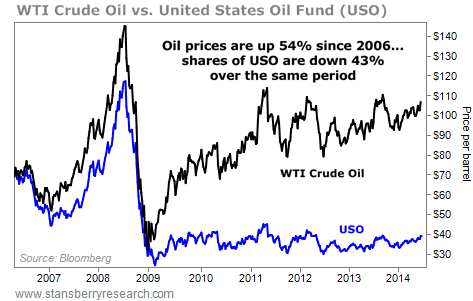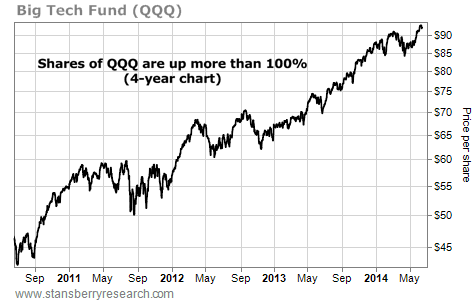| Home | About Us | Resources | Archive | Free Reports | Market Window |
The Right Way to Buy a Commodities FundBy
Tuesday, June 17, 2014
For the first time in years, I'm buying commodities...
In the March issue of my True Wealth Systems service, I recommended a very specific way to buy commodities – through an exchange-traded fund (ETF).
Most people don't know this... but investing in commodities is tricky... Doing it the wrong way can result in BIG losses – even if commodity prices go higher.
Today, I'll show you why that is. And more importantly, I'll show you how to get around the problem, and potentially make big gains in commodities, starting now.
Let's get started...
Most folks don't know just how dangerous investing in commodities is. The problem with investing in commodities isn't with the actual commodities at all... The problem is how typical investors make commodity investments.
Here's an example...
During the financial crisis in late 2008, the price of oil fell below $40 a barrel. Today, oil is up over $100 a barrel.
If you'd bought oil at the bottom in late 2008 through an oil index fund that tracks the price of oil, then you would have tripled your money, right?
Not so fast...
Most individual investors would have bought the United States Oil Fund (USO) to take advantage of oil prices potentially rising. This fund exists to track oil prices. It attempts to do so by using "futures" contracts.
Buying oil in late 2008 would have been a brilliant idea... But if you'd bought shares of USO to make the trade, you would have lost money.
While the price of oil has soared from under $40 a barrel to over $100 a barrel, the price of USO is still below $40.
Take a look:
 What went wrong? How could an investment thesis that was right turn so sour? The answer to those questions – and the reason investing in commodities can be dangerous – is explainable with a single word... "contango."
I'd bet 99% of investors have never heard of contango. But it's incredibly important when it comes to investing in commodities. And it's the exact reason shares of USO dramatically underperformed oil prices.
You see, USO doesn't hold barrels of oil. Instead, it invests in oil by purchasing oil futures contracts. These are an agreement to buy a certain asset – oil in our example – at a certain price on a certain day.
In the case of oil, there is a futures contract for every month of the year. The way those prices relate to each other can create contango. In short, contango means that next month's price of a commodity is higher than this month's price.
The table below shows hypothetical oil futures prices. These aren't today's actual prices, but they isolate the problem of contango. Take a look:
As you can see, the lowest-priced futures contract in this example is the current month (known as the "front month"). As you go farther out in time, prices get higher and higher. This is a killer for investors... You see, USO attempts to track oil prices by holding the front-month futures contract. The front month usually has the most trading volume and most accurately tracks the true commodity price.
However, when the current front month expires, USO must "roll" the position into the next month's futures contract. And when contango exists, that's expensive...
In this case, selling the July contract nets $100. USO then immediately buys the August contract for $102. In short, the fund loses $2 for every contract it owns.
This happens month after month to commodity funds when the commodity they own is in contango. In the case of USO, it turned a trade that should have been up 200%-plus into less than 50% gains.
However, there's one commodities fund that turns this idea on its head. Instead of losing money to contango, it makes money from it... and beats the benchmark commodity index in the process...
The fund goes by a simple name... the U.S. Commodity Index Fund (USCI). And this fund's unique structure makes it a fantastic way to profit from a commodities boom.
You see, USCI tracks the SummerHaven Dynamic Commodity Index (SDCI). SDCI strives to take advantage of situations in commodities that tend to happen over and over to produce superior returns.
In short, instead of buying and holding all commodities like a typical fund, the SDCI only holds the commodities that history says should perform the best over the next month.
Specifically, it holds 14 of 27 possible commodities based on two simple criteria...
These two criteria have been proven over decades to make real money. Let me briefly explain them... The first criterion, "backwardation" – is simply the opposite of contango. This means the SDCI specifically buys commodities that allow it to make money by "rolling" positions.
For example, the current July oil futures contract sells for $106.83, as I write. Meanwhile, the August contract sells for $106.21. Unlike the contango situation I described before, this scenario leads to profits when the position "rolls" forward.
The SDCI would sell the July contract for $106.83 and buy the August contract for $106.21... which results in a GAIN of $0.62 per contract.
In short, the SDCI not only avoids the problem that makes most commodity funds terrible investments... it makes extra gains by doing the opposite trade.
The SDCI selects its first seven commodities based on this idea... buying the commodities with the largest backwardation available.
It selects its next seven holdings based on the strongest uptrends in commodities (based on trailing 12-month price change).
Over the last 20 years, this way of investing has delivered huge gains...
You see, while the CRB increased just 134% in value over that period, the SDCI returned nearly 10 times that gain... up a staggering 1,331%. And based on annual gains, the SDCI tripled the return on general commodities... up 14.2% a year versus 4.3% a year for the CRB.
Like I said, commodities can be dangerous for the average investor. But with shares of the United States Commodity Fund (USCI), we're able to rid ourselves of the usual problems.
History shows USCI isn't just safer, it should lead to much larger gains as well. With commodity prices finally beginning to move higher lately, it's an opportunity you don't want to miss.
Good investing,
Steve
Further Reading:
Steve recently told readers about one commodity in particular that he's excited to buy right now. "Timberland is a fantastic asset to own at the right time," he writes. "And now is the right time." Click here to learn why.
S&A Editor in Chief Brian Hunt recently shared a "commodity" that has proven to be the world's greatest defense against inflation – even better than gold. Find out what Brian is talking about right here.
Market NotesOUR BIG CHEAP TECH TREND KEEPS ROLLING After taking a "breather" in March and April, the uptrend in tech stocks is back on.
Longtime readers know that the tech sector has been a favorite of ours in recent years. Back in September 2010, Steve Sjuggerud pointed out how many of America's elite tech companies were trading at extremely low valuations. You just had to account for their giant cash hoards to realize it.
Our "Big Cheap Tech" idea includes the biggest and best companies in the sector. Companies like Microsoft, Intel, and Apple have thick profit margins, generate huge amounts of cash, and pay growing dividend streams to shareholders.
Below, you can see the steady uptrend in shares of QQQ, a popular sector fund. It's a "one click" way to own 100 of the biggest names in tech. Like most areas of the stock market, tech stocks "took a breather" in March and April. Since late May, the uptrend has resumed. Shares of QQQ broke out to a fresh 13-year high. The uptrend in Big Cheap Tech continues.
 |
Recent Articles
|


